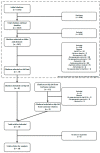Responders to Exercise Therapy in Patients with Osteoarthritis of the Hip: A Systematic Review and Meta-Analysis
- PMID: 33050412
- PMCID: PMC7600967
- DOI: 10.3390/ijerph17207380
Responders to Exercise Therapy in Patients with Osteoarthritis of the Hip: A Systematic Review and Meta-Analysis
Abstract
The Outcome Measures in Rheumatology workgroup (OMERACT), together with the Osteoarthritis Research Society International (OARSI) developed the OMERACT-OARSI responder criteria. These criteria are used to determine if a patient with osteoarthritis (OA) 'responds' to therapy, meaning experiences a clinically relevant effect of therapy. Recently, more clinical OA trials report on this outcome and most OA trials have data to calculate the number of responders according to these criteria. A systematic review and meta-analysis were performed on the response to exercise therapy, compared to no or minimal intervention in patients with hip OA using the OMERACT-OARSI responder criteria. The literature was searched for relevant randomized trials. If a trial fit the inclusion criteria, but number of responders was not reported, the first author was contacted. This way the numbers of responders of 14 trials were collected and a meta-analysis on short term (directly after treatment, 12 trials n = 1178) and long term (6-8 months after treatment, six trials n = 519) outcomes was performed. At short term, the risk difference (RD) was 0.14 (95% confidence interval (CI) 0.06-0.22) and number needed to treat (NNT) 7.1 (95% CI 4.5-17); at long term RD was 0.14 (95% CI 0.07-0.20) and NNT 7.1 (95% CI 5.0-14.3). Quality of evidence was moderate for the short term and high for the long term. In conclusion, 14% more hip OA patients responded to exercise therapy than to no therapy.
Keywords: exercise therapy; hip osteoarthritis; meta-analysis; responders.
Conflict of interest statement
Dr. Bierma-Zeinstra reports grants from the Netherlands Organisation for Health Research and Development (Health Care Efficiency Research Programme), during the conduct of the study; grants from Dutch Arthritis Foundation, the Netherlands Organisation for Health Research and Development, and EU Horizon 2020, Stichting Coolsingel, Nuts-Ohra, and EU Fp7, other from Regeneron, Infirst healthcare, personal fees from Osteoarthritis & Cartilage, personal fees from OARSI, EULAR, Regeneron, and Infirst health care, outside the submitted work. The other authors certify that he or she has no commercial associations (e.g., consultancies, stock ownership, equity interest, patent/licensing arrangements, etc.) that might pose a conflict of interest in connection with the submitted article.
Figures
References
-
- RIVM Volksgezondheidenzorg.Info. [(accessed on 25 September 2020)]; Available online: https://www.volksgezondheidenzorg.info/onderwerp/artrose/
-
- Bannuru R.R., Osani M.C., Vaysbrot E.E., Arden N.K., Bennell K., Bierma-Zeinstra S.M.A., Kraus V.B., Lohmander L.S., Abbott J.H., Bhandari M., et al. Oarsi guidelines for the non-surgical management of knee, hip, and polyarticular osteoarthritis. Osteoarthr. Cartil. 2019;27:1578–1589. doi: 10.1016/j.joca.2019.06.011. - DOI - PubMed
-
- Fernandes L., Hagen K.B., Bijlsma J.W., Andreassen O., Christensen P., Conaghan P.G., Doherty M., Geenen R., Hammond A., Kjeken I., et al. Eular recommendations for the non-pharmacological core management of hip and knee osteoarthritis. Ann. Rheum Dis. 2013;72:1125–1135. doi: 10.1136/annrheumdis-2012-202745. - DOI - PubMed
Publication types
MeSH terms
LinkOut - more resources
Full Text Sources
Miscellaneous



